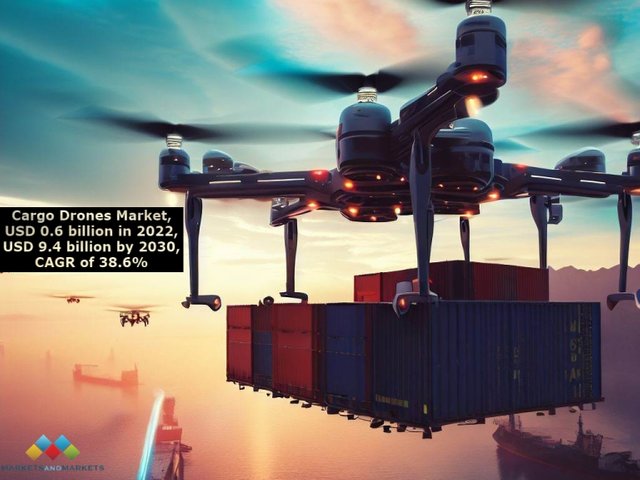
The Cargo Drone Market is experiencing rapid growth, driven by various factors such as the reduction in CO2 emissions and carbon footprint, increasing B2B middle-mile logistics, and advancements in technology. The market size is estimated to be USD 0.6 billion in 2022 and is projected to reach USD 9.4 billion by 2030, with a Compound Annual Growth Rate (CAGR) of 38.6% from 2022 to 2030. In this blog post, we will explore the key players in the cargo drone market, their innovations, and market dominance.
Reduction in CO2 Emissions and Carbon Footprint: A Driving Factor
One of the significant drivers of the cargo drone industry is the urgent need to reduce CO2 emissions and carbon footprint in the transportation sector. Delivery trucks, which contribute significantly to greenhouse gas (GHG) emissions, emit around 415 million metric tons of carbon dioxide each year in the US alone. Cargo drones offer a more environmentally friendly alternative by cutting down CO2 emissions. According to a study conducted by Inmarsat and Cranfield University, drones with a 36-kilometer range emit around 2,160 grams of CO2 per 24 hours, compared to 3,394 grams emitted by light commercial vehicles delivering 10 packages per 8-hour shift.
The GHG emissions associated with cargo drones vary based on their payload capacity. Small payload drones have lower emissions per package than electric trucks and larger cargo drones. By improving the energy efficiency of warehouses and reducing electricity generation from carbon-intensive fuels, significant benefits can be achieved. Cargo drones' ability to consume less energy per hour, operate on lithium-ion batteries, and leave a smaller carbon footprint makes them an attractive solution for reducing carbon emissions in transport.
Uncertainty in Regulations: A Restraint to Market Growth
While cargo drones offer promising solutions, their operations are subject to regulations and approvals from respective governments. The airspace of different countries requires proper air traffic management, data support, controller training, and social adaptability. Governments worldwide are making efforts to enhance their defense capabilities by developing new technologies or advancements in existing drone technologies. However, compliance with country-specific drone regulations and the ability to control drones in a regulated environment is crucial.
The uncertainty and cost associated with developing drone infrastructure and obtaining necessary approvals pose challenges to market growth. Political hurdles, coupled with the cost of infrastructure development, may hinder changes in existing policies to enable the widespread use of cargo drones. These factors contribute to the complexity and uncertainty surrounding the growth of the cargo drone market.
Increasing B2B Middle-Mile Logistics: A Lucrative Opportunity
Middle-mile logistics, often overlooked compared to last-mile delivery, presents a significant opportunity for cargo drones. Unlike last-mile delivery, which focuses on delivering goods from retailers to customers, middle-mile logistics involves transportation between businesses, such as from ports to distribution centers or distribution centers to stores. Cargo drones designed for middle-mile logistics have larger payload capacities and longer ranges than those used for last-mile delivery.
Companies are recognizing the cost advantages of middle-mile drones over conventional transportation methods for transporting larger cargo over longer distances. FedEx and Elroy Air's collaboration to investigate autonomous solutions for middle-mile delivery operations is a prime example of the industry's focus on this area. Similarly, Leonardo S.P.A, FlyingBasket, and Poste Italiane's joint effort in conducting drone-based delivery experiments for middle-mile delivery signify the growing interest in this market segment.
Sudden Changes in Weather Conditions: A Challenge for Cargo Drones
Weather conditions pose a challenge to cargo drones, as sudden changes can affect their predetermined flight paths. Drones are susceptible to weather conditions, and their specifications determine their ability to withstand adverse weather. Advanced weather data plays a crucial role in ensuring safe and efficient drone missions, particularly for weather-sensitive operations.
Factors such as wind speed, precipitation, and extreme temperatures can impact flight operations. High temperatures can reduce battery performance and limit flight time, while strong winds can increase battery usage or cause drones to lose control. Drones' ability to operate effectively in adverse weather conditions is essential for their successful deployment in various applications. Therefore, mitigating the challenges associated with weather conditions is crucial for the cargo drone market.
Key Players in the Cargo Drones Market
The cargo drone market is dominated by globally established players who offer a diverse product portfolio, advanced technologies, and strong global sales and marketing networks. Prominent companies in this market include Phoenix Wings, Gadfin, Steadicopter, Airspace Experience Technologies Inc., and Drone Delivery Canada Corp. These companies have been operating in the market for several years, contributing to its growth and innovation.
The cargo drone market is experiencing significant growth, driven by the need to reduce CO2 emissions, increase B2B middle-mile logistics, and advancements in technology. Challenges such as uncertainty in regulations and weather conditions need to be addressed for sustained market expansion. The key players in the market, with their innovations and market dominance, play a vital role in shaping the future of cargo drone operations.
As the market continues to evolve, it is expected that cargo drones will become an integral part of various industries, including retail, healthcare, agriculture, defense, and maritime. With Asia Pacific leading the growth in this sector, countries such as India, China, and Japan are investing in cargo drone capabilities. The cargo drone market presents immense potential for companies that can navigate the challenges and capitalize on the opportunities presented by this emerging technology.
To know More About Cargo Drones Market, Request a FREE PDF Brochure: https://www.marketsandmarkets.com/pdfdownloadNew.asp?id=252936360